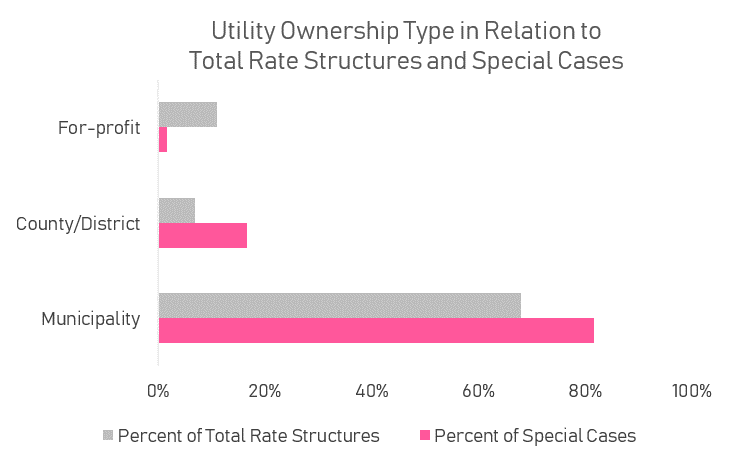In the course of conducting our statewide utility rates surveys, we here at the Environmental Finance Center at the University of North Carolina at Chapel Hill examine thousands of rate structures each year. We’ve seen it all, from the especially complex to the most basic. One thing we have noticed is that sometimes utilities create complicated rate structures when the same outcomes could be accomplished in simpler ways. We internally deem these “special cases.”
Everyone wants to be special, right? But when it comes to rate structures, special often means needlessly convoluted. One of the most important objectives for utilities should be to communicate their rates clearly to their customers. When rate structures are complicated, communication with customers also becomes complicated. Simple rate structures can have the same desired outcomes as more complex ones, while making communication with customers more straightforward and billing easier. It can pay to be plain.
Let’s look at an example of an actual special case rate structure (numbers have been modified slightly for anonymity):

It is uncommon for a rate structure to have multiple base charges based on the user’s consumption, which is why this stands out. In this example, the lower base charge for using over 3,000 gallons could appeal to customers. The catch is that the customer still has $6.81 added to the bill for using those 3,000 gallons, making the “lower” base charge option actually total $22.21— only $0.48 cheaper than the original $22.69 (see math below). Furthermore, the lower listed “rate” of $2.27 is not actually used volumetrically, only as a block of 3,000 gallons to be added to the second base charge. It raises the question: Why have a second base charge and rate that barely differ from the first? What is achieved through this confusing method?

Here is a simpler rate structure with the same consumption allowance that accomplishes the nearly the exact same bill:

That’s it; the humble uniform rate does the job just as well as the more complicated rate structure, without the potential for misleading the customer the way the special case does. It’s easy to explain to all customers, and simplifies billing by removing the extra step of differentiating customers based on their consumption. The greatest difference in price between these two rate structures occurs at 4,000 gallons, with the simplified version adding a total of $0.44 to the bill.

The above graph shows how closely the bills for the special case and simplified rate structure match. Though this graph only goes up to 10,000 gallons (within the normal range of residential consumption), even beyond that the greatest difference between the two is $0.56 at 30,000 gallons. It is safe to say that there is practically no benefit to the more complicated rate structure.
Overall, special cases make up just over 1 percent of 4,662 residential rate structures modeled by the EFC in NC, GA, AL, HI, WI, IL, AZ, NH, MA, and CT between 2016 – 2018. There are also special cases that apply to non-residential and irrigation rates, which have not been included here. In some states, special cases account for up to 3 percent of all residential rate structures. There are also some states, such as Wisconsin, that have no special cases at all.
Wisconsin’s lack of special cases may be due to the fact that the Public Service Commission of Wisconsin has regulatory oversight over rates set by local governments. In most states besides Wisconsin, local government rates are approved locally without oversight from the state or the utilities commission. As shown below, local governments have disproportionately higher instances of special cases, whereas for-profit utilities that are regulated by a utilities commission rarely use special case rate structures. Utilities with less oversight have more room for creativity in designing their rate structures. However, that room for creativity should not lead to over-designed rate structures that help neither the customers nor the utility. Sometimes the best solutions are the most simple, not the most special.

If your utility is utilizing a complicated rate structure design, it’s worth considering if there is a simpler way to achieve the same outcome. Chances are if it looks odd to us, it may be confusing to your customers as well, and may increase opportunities for billing errors.
Need help figuring out how to restructure or effectively communicate your rates? Check out the resources below:
- Designing Rate Structures to Support Your Objectives
- Four Keys to Creating Useful Utility Rate Sheets
Special thanks to Shadi Eskaf, Helen Drotor, and Elizabeth Kendrick for their help in putting this post together.
Annalee Harkins joined the Environmental Finance Center at the University of North Carolina in 2016. She holds a BS in Information Science with a minor in Environmental Science from the University of North Carolina at Chapel Hill, as well as a diploma in Art & Design from London College of Fashion. Annalee is responsible for data visualization and project management of utility rate surveys and online dashboards. Before joining the EFC at UNC, Annalee worked as an Analyst for IronOak Energy Insights and as a photographer. Outside of work, Annalee enjoys spending time with her dogs, sewing quilts by hand, and reading.

